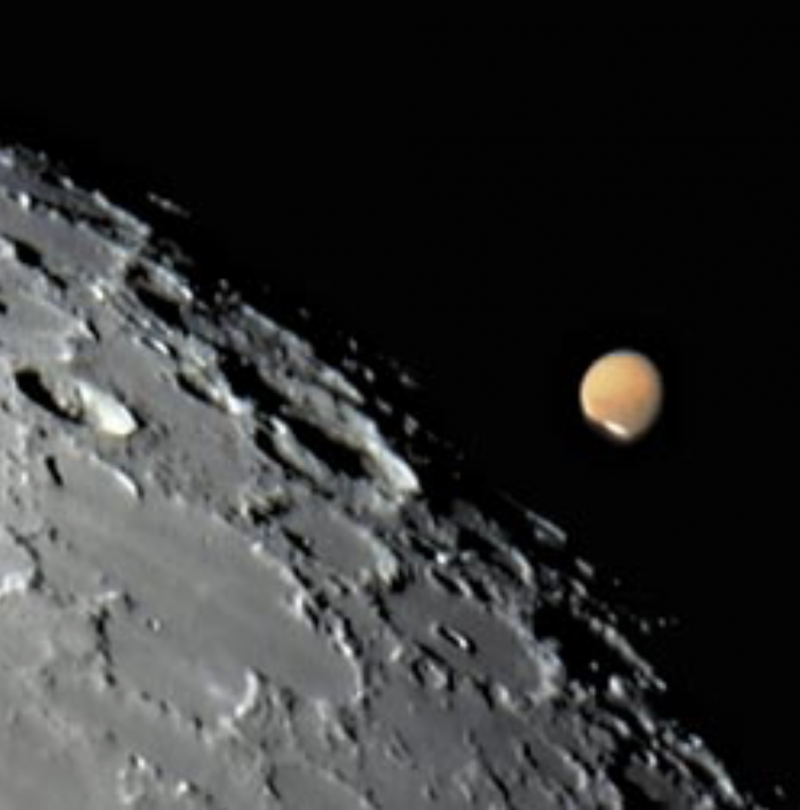
Do you live in North or Central America? If so – on the morning of February 18, 2020 – you might be in just the right place to watch the waning moon occult (cover over) the red planet Mars. Mars will slip behind the moon’s illuminated side and then reappear on the moon’s dark side. For many North American localities, the entire occultation will last for well over one hour.
Given clear skies, all of the United States (with the exception of Alaska and Hawaii) will be in a position to watch this lunar occultation of Mars. But whether this occultation takes place before dawn, at dawn, or in a daytime sky, depends on where you live within the United States. Even in the predawn sky, however, your view of the occultation could be less than ideal because of light pollution. In that case, use binoculars!
For those living in the Pacific Time zone, the entire occultation happens during the predawn hours on February 18.
In the Mountain Time zone, the occultation begins in a predawn sky and ends in a predawn or dawn sky.
From the Central Time zone, the occultation starts in a predawn/dawn sky and then ends at dawn or after sunrise. You should be able to see Mars before the occultation with the eye alone, but may need an optical aide to view Mars’ reappearance.
For the residents of the eastern United States (Eastern Time zone), the occultation takes place after sunrise February 18, so a telescope is in order for watching the event from the eastern U.S. and Canada.
The moon will cover up Mars five times in 2020, but February’s occultation is the only one that will be accessible to viewers in much of North and Central America.
Click on this IOTA page to find the occultation times in Universal Time (UTC) for over 700 North American localities. To convert UTC to your local clock time: Eastern Standard Time = UTC -5 hours, Central Standard Time = UTC -6 hours, Mountain Standard Time = UTC -7 hours, and Pacific Standard Time = UTC -8 hours.
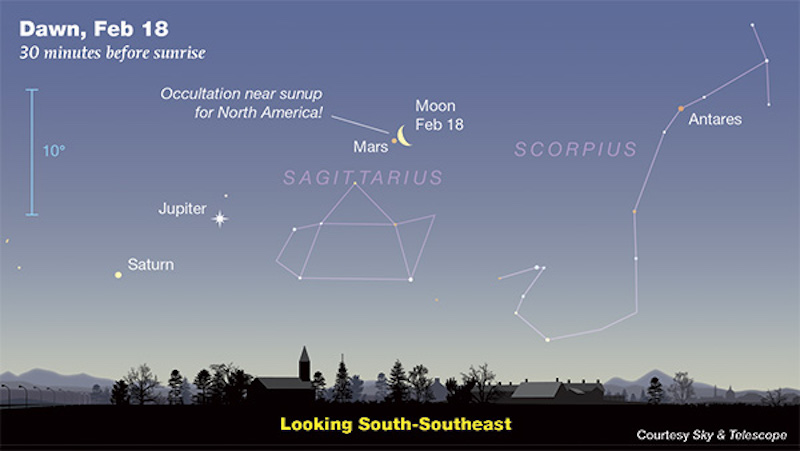
How to find occultation times for your sky
Let us start on the West Coast and take Los Angeles, California, as our example of how to convert Universal Time (UTC) to local clock time. First, we click on this IOTA (International Occultation Timing Association) page. Then we scroll down beneath the subheading Disappearance to US Los Angeles Ca to find that the occultation begins (Mars disappears) at 11:38:04 UTC. (Note the number 548 in front of Los Angeles.) After that, we scroll down past the subheading Reappearance to 548 US Los Angeles Ca to find that the occultation ends (Mars reappears) at 12:29:13 UTC. We subtract 8 hours to convert UTC to Pacific Time:
For Los Angeles, California (Pacific Standard Time):
Occultation begins (Mars disappears behind moon’s lit side): 3:38:04 a.m. PST on February 18. 2020
Occultation ends (Mars reappears from behind the moon’s dark limb): 4:29:13 a.m. PST on February 18, 2020
Important note for those living along the West Coast: Look at the map of the lunar occultation of Mars below via IOTA. Note the teardrop-shaped loop at the upper left (over the U.S. northwest coast/Canadian southwest coast). From this swath of the occultation viewing area, people cannot watch Mars disappear behind the moon’s lit side, because the occultation is already in progress at moonrise on February 18, 2020.
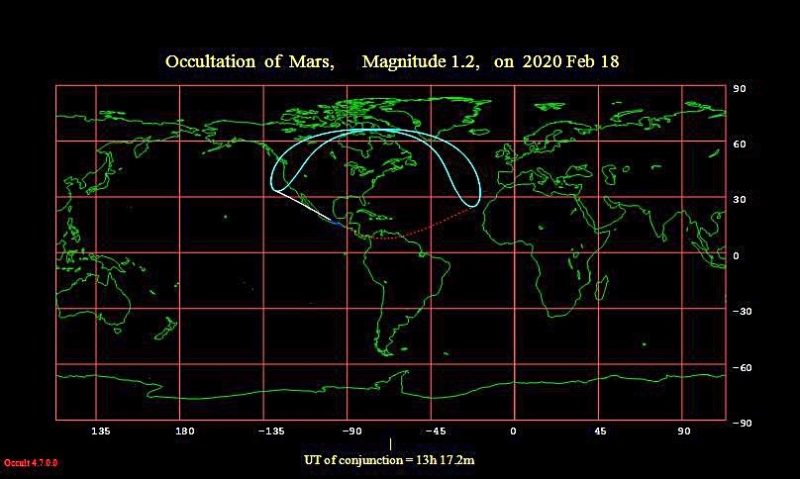
The cities listed below in the PST zone reside within this loop. From here, people will miss out on viewing Mars’ disappearance, but will be able to watch Mars reappear in a dark sky at the occultation’s end. We give the times of Mars’ reappearance in Pacific Standard Time:
Vancouver, Canada: Mars reappears at 4:49:18 a.m. PST on February 18, 2020
Seattle, Washington: Mars reappears at 4:47:41 a.m. PST on February 18, 2020
Portland, Oregon: Mars reappears at 4:44:44 a.m. PST on February 18, 2020
San Francisco, California: Mars reappears at 4:20:57 a.m. PST on February 18, 2020
The above map outlines the occultation viewing area. The multicolored curve at the bottom gives you some idea of where the occultation takes place in a predawn sky, dawn sky or daytime sky. The solid white line signifies a dark predawn sky, the short blue line a dawn sky, and the dotted red line a daytime sky.
For your convenience, we list the local occultation times for a chosen city in Mountain Standard Time, Central Standard Time and Eastern Standard Time. Within the same time zone, the occultation times vary but stay within the general ballpark:
Denver, Colorado (Mountain Standard Time):
Occultation begins (Mars disappears behind moon’s lit side): 4:41:49 a.m. MST on February 18. 2020
Occultation ends (Mars reappears from behind the moon’s dark limb): 6:02:13 a.m. MST on February 18, 2020
Sunrise: 6:49 a.m. MST on February 18, 2020Omaha, Nebraska (Central Standard Time):
Occultation begins (Mars disappears behind moon’s lit side): 5:52:43 a.m. CST on February 18. 2020
Occultation ends (Mars reappears from behind the moon’s dark limb): 7:18:42 a.m. CST on February 18, 2020
Sunrise: 7:14 a.m. CST on February 18, 2020New York, New York (Eastern Standard Time):
Sunrise: 6:47 a.m. EST on February 18, 2020
Occultation begins (Mars disappears behind moon’s lit side): 7:36:37 a.m. EST on February 18, 2020
Occultation ends (Mars reappears from behind the moon’s dark limb): 9:05:49 a.m. EST on February 18, 2020
Typically, when a star is occulted by the moon, that distant pinpoint of light tends to immediately disappear at the beginning of the occultation and then to instantly reappear at the end. But since Mars is a relatively nearby planet, this disk-like object takes a little time to fully disappear and then to fully reappear, especially as viewed through the telescope.
Go to this IOTA page to find the occultation times in Universal Time (UTC) for hundreds of localities in North America (Canada, U.S. and Mexico) plus Central America. To convert UTC to your local clock time:
Eastern Standard Time = UTC -5 hours
Central Standard Time = UTC -6 hours
Mountain Standard Time = UTC -7 hours
Pacific Standard Time = UTC -8 hours
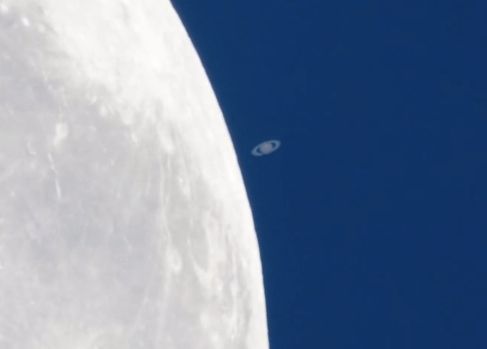
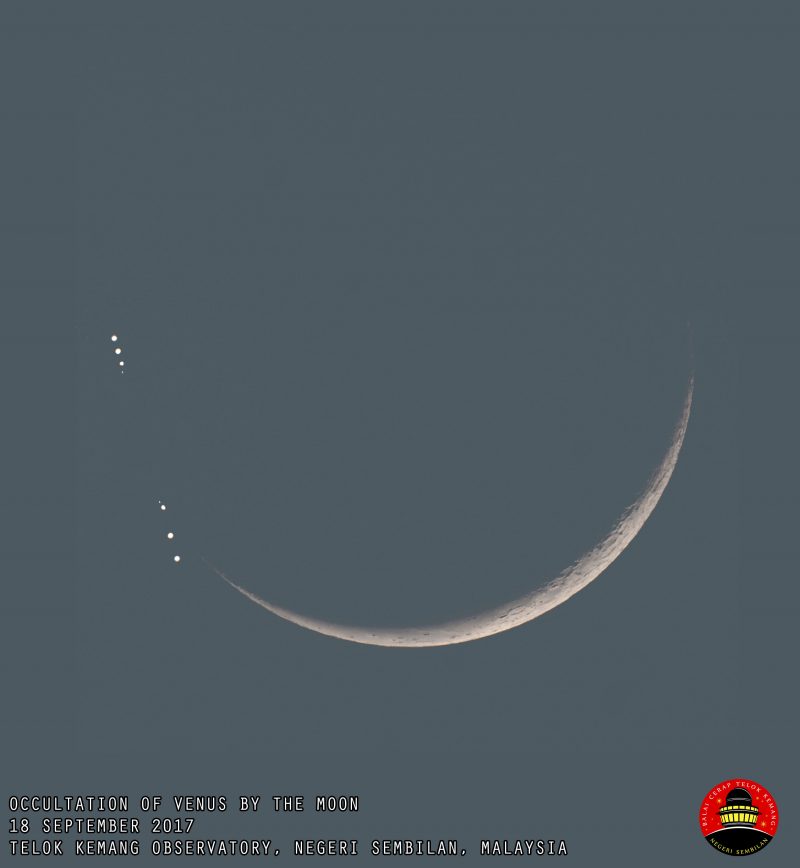
Along the Pacific Coast in Mexico and Central America, it might be possible to catch a grazing occultation with Mars passing along the edge of the lunar disk, flitting in and out of the lunar highlands. Look for this grazing occultation in a predawn sky along the Mexican west coast, or in a dawn/daytime sky along the Central American west coast, and daytime sky in far northern South America.

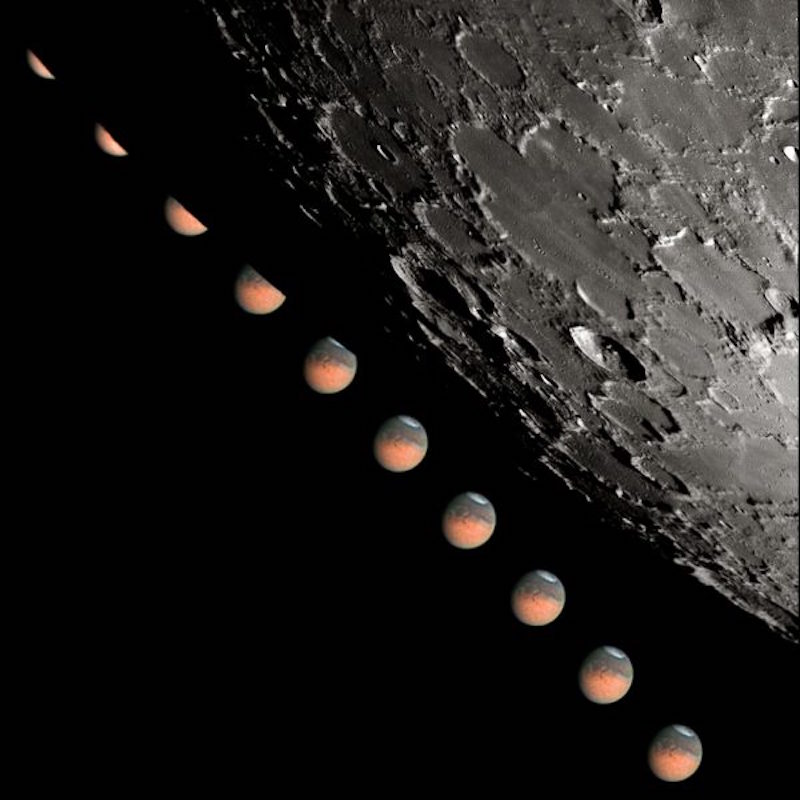
Bottom line: If you live in the right place in North or Central America, you have a chance to catch a lunar occultation of Mars on the morning of February 18, 2020. In the western half of the United States, this occultation takes place in a dark sky and may be viewed with the eye alone. In the eastern half of the United States, the occultation happens at late dawn or after sunrise, so you’ll likely need a telescope to witness the occultation of Mars in a daytime sky.











